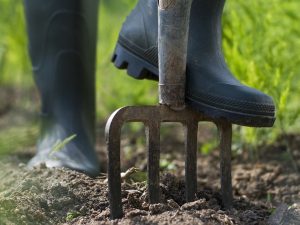Soil testing is a very useful way of seeing how your soil improvement techniques are working, what is working well and what isn’t. Simple tests that you can do without expensive or complicated tools or laboratory tests can be very useful in determining progress. Figures used in the soil testing we do are only useful in comparison to the developing soil changes of the specific site, or its neighbours, to see if soil management techniques employed are having a positive or negative effect on the soil. Keeping a journal, or annotated map detailing when, where and when soil tests are carried out and what the results are is a great way to measure progress of a field or growing bed and reacting appropriately is a key component to good soil management.
Moisture
Plants will wilt if soil moisture drops below 5% (clay) or 15% (sand) within the root zone.
Soil should be above 50% moisture at 6 inches (15cm) depth 2 days after a good rain, or it is excessively drained.
Drainage
Simple
- Dig a hole 1 foot (30cm) deep by 6” (15cm) across, then fill with water
- Once drained, fill with water again. Time how long it takes to soak in – record this; the less time it takes the better the drainage. This can be done regularly to see if land is becoming more or less drained. As a general guide, if it takes 8 hours plus, drainage is very poor
Intermediate
- When soil is neither too wet nor too dry, empty a pint (0.6 litres) of water at soil level and start recording seconds
- When the water has completely soaked into the ground, stop counting and measure the diameter of the wet spot
- Multiply the diameter by the number of seconds to soak in, and record. Repeat 3 or 4 times in each spot over the summer – helps to track subtle changes in moisture retention. Declining numbers indicates less erosion, more absorbtion etc.
Soil structure
Simple
- Place a small handful of soil in a glass of water
- In soil with good structure the aggregates should stay together. If they collapse into a muddy blob you do not have good structure. Good structure = lots of large crumbs holding together
Compaction
Simple
- Get a metal rod around 1/4” (6mm) thick, mark depths on it and push into the soil – record the depth it bends under pressure. Good for comparisons
- Alternatively use a penetrometer to do this more accurately
Bulk density
Bulk density is the weight of a given volume of soil.
Intermediate
- Scrape away surface soil to a level, dig a hole 6” (15cm) deep 4” (10cm) wide, putting all the soil you remove in a bag
- Put a plastic bag inside the hole and fill with a measured amount of water, up to the level. This gives the volume of soil removed
- Dry the soil properly, i.e. on a tray in the oven on very low for a day. When dry, weigh in grams
- Get the bulk density by dividing weight of soil (g) by volume (ml). A good range is 1.0 – 1.8 g/ml – more than 2.0 is a sign of compaction
Worm test
Simple
- Take a 6″ x 6″ (15cm x 15cm) x 1ft (30cm) deep sample of soil
- Break apart and count worms. Worms are a good indication of basic soil health – soil with lots of worms is likely to be fertile, and well-aerated, as these are both the conditions that worms like, and they help to create
- Average soil typically has between 4-8 worms; poor soil has less than 4 and good soil will have above 8.
Soil horizon
- How thick is the topsoil?
- How deep do plant roots penetrate? (look especially for a compacted layer that no roots can penetrate)
- How far down can you see worm tunnels?
- Mottled grey and rust brown streaks in lower horizons indicate leaching, acid soils
- Brown and red colours (oxidised Iron) are a result or acidity
- Absence of definite horizons indicates either very deep topsoil or organic soil (not tilled)
Erosion
To check on a slope.
Simple
- On the higher part of the slope, drive a hollow pipe into the soil, so that the soil level inside the cylinder is the same as that outside
- Cover, and check periodically – if the soil outside is lower than inside, soil is being lost
Simple
Sink a shallow pan level with the soil, angled with the slope. If it collects runaway soil after a heavy rain, erosion is happening.
Field capacity
Field capacity is how much water your soil can hold when saturated – increased field capacity = increased humus content.
Intermediate
- Wait until the day after a soaking rain. Dig up about 40g of soil from 2-4” (5-10cm) deep
- Weigh sample, then dry it (as in bulk density test)
- Weigh the dry sample
Wet weight of soil divided by dry weight of soil, multiplied by 100 = field capacity (%)
For comparison, field capacity of well-granulated silt loam is about 15%
Thanks to Simon White of Stepney City Farm.
Also, see here for soil advice and soil testing booklets from the Permaculture Association.

